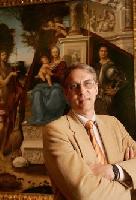David Stork, expert on computer analysis of art, to give annual C. P. Snow Lecture
04/05/11
Contributed by Craig Duncan
 Computer scientist David G. Stork will tell — and show — how computer image analysis is changing our understanding of art in a free public talk at Ithaca College on Thursday, April 14. The talk, entitled "When Computers Look at Art: Image Analysis in Humanistic Studies of the Visual Arts” will take place at 7 p.m. in Textor 102. You may never see paintings the same way again after this lecture, which will be generously illustrated with works by Pollock, van Gogh, Jan van Eyck, Hans Memling, Lorenzo Lotto and others.
Computer scientist David G. Stork will tell — and show — how computer image analysis is changing our understanding of art in a free public talk at Ithaca College on Thursday, April 14. The talk, entitled "When Computers Look at Art: Image Analysis in Humanistic Studies of the Visual Arts” will take place at 7 p.m. in Textor 102. You may never see paintings the same way again after this lecture, which will be generously illustrated with works by Pollock, van Gogh, Jan van Eyck, Hans Memling, Lorenzo Lotto and others.
What can computers reveal about images that even the best-trained connoisseurs, art historians and artists cannot? New computer methods are being used to shed light on a number of recent controversies in the world of art. For example, fractal analysis has cast doubt on the authenticity of a cache of paintings attributed to Jackson Pollock, while computer analysis of shading and perspective has also shed light on the debate over David Hockney's bold claim that as early as 1420, artists were using optical devices such as concave mirrors to project images on to their canvases.
Dr. David G. Stork is Chief Scientist of Ricoh Innovations and has taught at Stanford University over the last 20 years. He has made over 220 scholarly presentations on computer analysis of art in 17 countries, including in major museums such as the Louvre, National Gallery London, Metropolitan Museum of Art, Museum of Modern Art, and many others. The breadth of Stork’s interests and contributions is perhaps best understood through the academic departments in which he has served: physics, mathematics, electrical engineering, statistics, computer science, neuroscience, psychology, and art and art history. His books include Seeing the Light: Optics in Nature, Photography, Color, Vision and Holography; Speechreading by Humans and Machines; and HAL’s Legacy: 2001’s Computer as Dream and Reality, which served as the basis for a PBS television documentary.
The presentation is sponsored by the C. P. Snow Lecture Series, named after the late British physicist and novelist Sir Charles Percy Snow, who was dedicated to bridging the gap between the sciences and the humanities. The series debuted in the School of Humanities and Sciences in 1964, and Snow was awarded an honorary doctor of letters degree from the college in 1967.
For more information, visit https://www.ithaca.edu/hs/events/series/cpsnow/. Individuals with disabilities requiring accommodation should contact the Office of Affirmative Action at 274-3909.
0 Comments
https://www.ithaca.edu/intercom/article.php/20110405141342214
 Computer scientist David G. Stork will tell — and show — how computer image analysis is changing our understanding of art in a free public talk at Ithaca College on Thursday, April 14. The talk, entitled "When Computers Look at Art: Image Analysis in Humanistic Studies of the Visual Arts” will take place at 7 p.m. in Textor 102. You may never see paintings the same way again after this lecture, which will be generously illustrated with works by Pollock, van Gogh, Jan van Eyck, Hans Memling, Lorenzo Lotto and others.
Computer scientist David G. Stork will tell — and show — how computer image analysis is changing our understanding of art in a free public talk at Ithaca College on Thursday, April 14. The talk, entitled "When Computers Look at Art: Image Analysis in Humanistic Studies of the Visual Arts” will take place at 7 p.m. in Textor 102. You may never see paintings the same way again after this lecture, which will be generously illustrated with works by Pollock, van Gogh, Jan van Eyck, Hans Memling, Lorenzo Lotto and others.